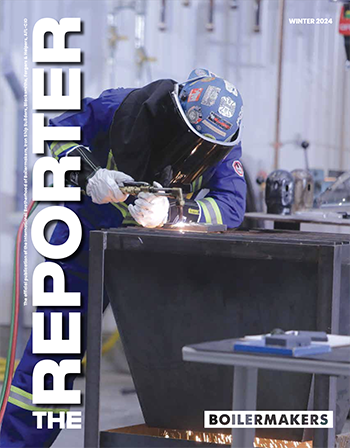While climate change has its skeptics, the Boilermakers union is not one of them. The body of evidence is too large not to be convincing.
With increasing polarization over the climate debate, not just in the United States and Canada but around the globe, the “leave it in the ground” voices clammer louder than all the others. They’d have people believe either the world cuts fossil fuels cold turkey and switches to purported “green” technology or the planet is damned.
In the discussion about reducing the effects of climate change there seems little room for middle ground. But the solution isn’t as simple as some environmental extremists claim.
While Boilermakers have traditionally worked in the oil and gas industry, the union’s members have also been at the forefront of mitigating climate change dating back decades. And as early as 2008 the Boilermakers were the union leaders shining a spotlight on the latest mitigation technology: carbon capture, use and storage.
Boilermakers have never been climate change deniers. As President Newton B. Jones stated clearly: “While climate change has its skeptics, the Boilermakers union is not one of them. The body of evidence is too large not to be convincing.”
Yet, the measured voice of compromise has gotten lost amid the chorus of voices vilifying fossil fuels.
In a recent radio interview, L-13 BM-ST John Bland questioned when collaboration ended and extremism began.
“When did environmentalists, engineers and unions stop working together?” he asked. “In the late ’70s we had acid rain and we got together and we fixed it. Now we’re in the 2000s and one side is saying ‘shut it down’ and another is backing them up.”
In 1970, with air pollution increasing, Congress passed the Clean Air Act, which set into motion a cascade of efforts to improve U.S. air quality. With environmentalists, scientists and unions working together, air quality improved.
International Vice President J. Tom Baca raised the question: “Where in the public dialogue is the middle ground? Where are climate change solutions that mitigate emissions contributing to climate change while preserving millions of middle-class union jobs?”
Where are climate change solutions that mitigate emissions contributing to climate change while preserving millions of middle-class union jobs?
The union has done both. Over the last 30-plus years, thousands of Boilermakers across the United States and Canada have been instrumental in alleviating the effects of climate change on the environment while earning a living wage with benefits and a pension. Members have spent decades installing bag houses, scrubbers, dry and wet precipitators, and other emission controls. All these measures vastly reduced particulate matter, nitrogen oxides, sulfur oxides, mercury and other emissions.
Retrofits throughout the 1970s and into the 2000s measurably cleaned the environment. Data from the Environmental Protection Agency show a sharp decrease in noxious emissions. For example, from 1995 to 2020, the annual emissions of sulfur oxides fell by 93%, annual emissions of nitrogen oxides from power plants fell 87% with carbon dioxide dropping 27%.
Some examples of Boilermaker retrofits and new builds include a billion-dollar wet scrubber on the West Coast at Valero’s Benicia Refinery in Benicia, California, in 2010. ARB, Inc. & Primoris Electric Inc. was one of the contractors on the retrofit. Vice President Larry Jansen said that many of their projects with Boilermakers are for “environmental improvement.” Most of these are SCRs or selective catalytic reduction, which is like putting a catalytic converter on your car to reduce emissions.
“It’s the most common retrofit,” Jansen said.
And it’s effective. According to the EPA, SCRs are capable of a reduction in sulfur dioxide in the range of 50% to 98% with the highest removal efficiencies achieved by wet scrubbers. Those have a greater than 90% efficiency.
In addition to retrofits, Boilermakers have been the workforce behind innovative green technologies such as the Ivanpah Solar Electric Generating System, which uses focused sunlight to turn water to steam and steam to electricity.
Newer supercritical and ultra-supercritical plants are burning coal at higher temperatures and pressures, reducing the amount of coal needed to produce the same energy output as comparable older units. Boilermakers helped to build the $4 billion, 1,600-MW Prairie State Energy Campus. The campus has twin 800 MW supercritical power generation units and an on-site coal mine with 200 million tons of recoverable coal—enough to fuel the plant for 30 years.
Moving into the future, no one can predict what new technologies will be invented, but a realistic mix of reliable energy sources that meet demand, preserve the environment and maintain union jobs is necessary.
“We’re going to have to keep a certain amount of our fossil fuels as we transition—until the next energy source,” said IVP Baca. “And we don’t know what that’s going to look like in 20 years. As energy changes and needs change, we’re going to be able to transition into that.”
While the technology is still costly, data on CCUS demonstrate that carbon capture technology will significantly reduce CO2 emissions while putting excess CO2 back in the ground, aiding in enhanced oil recovery. But positive change that both maintains a middle-class standard of living and cleans up the environment won’t happen unless extremists drop the political hot potato.
According to AD-CSO/Canada Cory Channon, who is also International Director of Climate Change Policy Solutions, it’s time to get people working on climate change mitigation to stop the rhetoric and political pandering and look at the facts: Fossil fuels power the nation—not just to fuel homes but to power the manufacturing of many of the goods and services that make life possible. In addition, as nations moves further into “green” technology, climate extremists don’t want to admit that fossil fuels are needed to build it.
As Jansen said, the U.S. needs comprehensive policy that’s balanced as the nation heads into a clean energy future.
“It’s concerning to me that people forget it takes lithium to make a battery,” he said. “Or what happens to the solar panels when they wear out. I don’t think it’s a well-informed way to progress into the future. There needs to be a balance in all of the above.”
As a Boilermaker who has carefully studied energy needs, climate change and solutions over the past years, Channon understands the need to clean up the environment and mitigate the effects of climate change across the globe. He also knows it can’t happen without a bridge of fossil fuels.
“The narrative that’s been created, that we’ve been led to believe, is that hydro, wind and solar are green and will live forever. That’s wrong. You’ve been misled,” Channon said. “We’re out there promoting a solution—carbon capture. Through that we preserve well-paid, meaningful jobs and increase job opportunities while we are mitigating greenhouse gas emissions.”
Pollution Control Terms
This method involves long, narrow bags suspended in a large enclosure. Fans blow the particulates upward, and they’re trapped inside the bag.
These can remove gasses, mists and solids simultaneously. They’re used to remove particles and gases from industrial exhaust streams as they pass through the duct network.
These remove particles from gas streams using an electricity to charge particles, which then attach to collector plates carrying an opposite charge.
This method captures carbon dioxide emissions then stores it deep in the ground. It can also be used for enhanced oil recovery and manufacturing of products.
Editor’s Note: This is the first in a series of three articles about energy production and climate change mitigation. Watch for an article in the Fall issue of The Boilermaker Reporter outlining the problems with green technologies.









